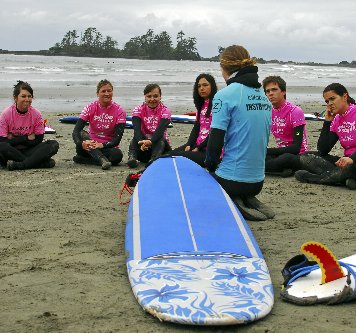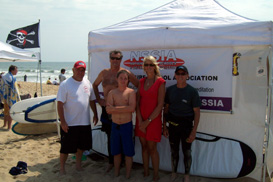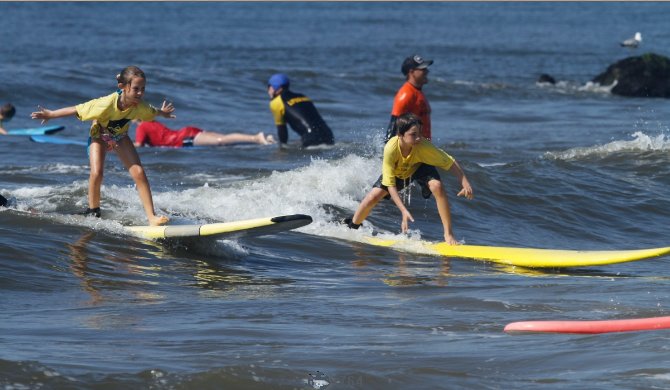 |
National Surf Schools & Instructors Association (NSSIA) | |||||||||||
| The
Official Professional Association for the Surf School Industry Protecting Both Industry and Students • Established 2005 AN IRS REGISTERED NON-PROFIT ORGANIZATION |
||||||||||||
|
||||||||||||
|
||||||||||||
NSSIA Safety Rules |
| FROM
ABC NEWS: First-Time
Surfers Cautioned About Rare Spinal Injury! Doctors Liken Surfer's Myelopathy to Spinal Stroke |
| ALL SURFERS MUST KNOW HOW TO SWIM Knowing how to swim is the best defense against drowning. Swimming instruction at an early age is a crucial step to protecting the surfer from injury or death. |
| SURF ON A LIFEGUARDED BEACH WHENEVER POSSIBLE Some areas have a lifeguard “monument” adjacent to the lifeguard tower which provide information on: wave heights, tide, water condition, water temperature, sea pests (sea lice, sharks, man o wars, jellyfish), the name of the lifeguard that’s on duty. If you surf too far away from the lifeguard tower it will take him that much longer to get to you if you get into trouble. You want that lifeguard in his best condition when he reaches you not overly exhausted from running or swimming a hundred yards to get to you. On the East Coast, lifeguard towers post several different colored flags for water safety conditions: red-dangerous, yellow-caution, green-normal, purple-sea pest If uncertain stop at lifeguard tower and inquire what the water conditions are, if any sea pests, tell him your level of surfing, and ask where would be the best spot for you to “line up” Lifeguards have first aid gear and AED equipment. They are trained and maintain certifications in Professional Rescuer CPR/AED and First Aid and ocean rescue. They also have the equipment to immediately activate local emergency medical services (EMS). |
| RIP TIDES OR "RIPS" The second most life threatening condition to surfers and swimmers is called RIP currents aka RIP tides although a misnomer as it is not a tide. Most waves are formed by wind on the water. Sea waves usually result from storms, often hundreds of miles from shore. Waves are not all equal in size. Sometimes a group of larger waves comes ashore one after another. This is known as a "set" of waves. When waves break, water is pushed up the slope of the shore. Gravity pulls this water back toward the sea. If it converges in a narrow, river-like current moving away from shore, it forms what is known as a rip current. Rip currents can be 50 feet to 50 yards or more wide. They can flow to a point just past the breaking surf (the surfline) or hundreds of yards offshore. Some 80% of rescues by lifeguards at America's surf beaches are due to persons being caught in rip currents. Rip currents may pull continuously, but they can suddenly appear or intensify after a set of waves, or when there is a breach in an offshore sandbar. Side currents, inshore holes, and other bottom conditions contribute to the formation of rip currents. |
RIP
CURRENT SURVIVAL
|
| DON'T DIVE HEADFIRST / PROTECT YOUR NECK Serious, lifelong injuries, including paraplegia, occur every year due to diving headfirst into unknown water and striking the bottom. When falling off a surfboard fall flat always extending a hand ahead of you. Surfing can result in a serious neck injury when the swimmer's neck strikes the bottom. Check for depth and obstructions before diving, then go in feet first the first time; and use caution while surfing, |
| PROTECT YOUR HEAD After falling off your board or “wiping out” always know where your surfboard is. As you come back to the surface after falling off your board use your hands and arms to protect your head by covering your head or extending your arms until you locate where the board is. Many a surfer has received head injuries from the board striking them on their head as a result of not protecting themselves properly. |
| SUN PROTECTION Of all of the various skin cancers, melanoma is known to be the most deadly if not caught in its earliest phases. Approximately 53,000 will be diagnosed with melanoma and 7,800 will die this year from melanoma. Melanoma = 5% of all skin caners / 71% of all skin cancer deaths. Skin caner kills more surfers than drownings and is the #1 cause of death in surfers. The Skin Cancer Foundation recommends SPFs of at least 15, which block 93 percent of UVB rays. While SPFs higher than 30 block only 4 percent more UVB, they may be advisable for sun-sensitive individuals, skin cancer patients, and people at high risk of developing skin cancer. They also allow some margin for error if too little sunscreen is applied. Rash guards with a high SPF rating also helps protects against cancer. They also help protect against rash caused by an allergic reaction to the use of certain types of surfboard wax, minimizes sliding around on surfboard from body oils, sunscreen or sunblock and for girls it helps keep their tops together. |
| USE A LEASH Surfboards should be used only with a leash. Leashes are usually attached to the board and the ankle or thigh. If the wave is keeping you under and you are unable to discern which way is to the surface you can follow the leash back to the surface. The surfboard will always stay on the surface even if the surfboard is broken the remainder that is attached to the leash will still be on the surface. A huge problem is a loose board hurting another surfer or especially a child if you are surfing closer to shore. The leash minimizes the distance the surfboard gets away from you. It also saves a swim to your board especially when you’ve been in the water for awhile are exhausted, get a cramp and unable to swim or get hit by another board and hurt or disoriented you can always rest on it until you regain your composure or help arrives. One additional consideration is a breakaway leash. A few drownings have been attributed to leashes becoming entangled in underwater obstructions. A breakaway leash avoids this problem. |
| NEVER DEPEND ON A LEASH AS
A LIFE SAVING DEVICE |
| THE BUDDY SYSTEM Always surf with at least one other person. Not only will you have more fun if you are sharing your waves but you will always have someone to help you out if you need it. |
| KNOW YOUR
LIMITATIONS! WHEN IN DOUBT, DON'T GO OUT! |
site map | contact | www.nssia.org
The National Surf Schools and Instructors Association (NSSIA) official website © 2005-2008 • All rights reserved
AN IRS REGISTERED NON-PROFIT ORGANIZATION


